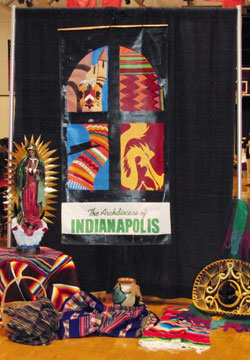Parishes must make Latinos feel at home, speaker says

This colorful display, including an image of Our Lady of Guadalupe, was featured at the Hispanic ministry event on Sept. 29 at Cardinal Ritter Jr./Sr. High School in Indianapolis. (Submitted photo)
By Sara Kovach (Special to The Criterion)
“It’s not only about welcoming Latinos into the parish, it’s about helping them feel at home,” said Franciscan Brother Moises Gutierrez, Hispanic ministry coordinator for the archdiocese.
This was the key message presented on Sept. 29 during “Serving One Another—Hispanic Presence in the Archdiocese,” a daylong event focused on Hispanic ministry in archdiocesan parishes.
The event was held at Cardinal Ritter Jr./Sr. High School in Indianapolis, and was open to all who minister, serve or volunteer at parishes and schools with a Latino presence.
No different than European immigrants
Keynote speaker Timothy Matovina, a professor of theology and executive director of the Institute for Latino Studies at the University of Notre Dame in Notre Dame, Ind., led the audience through the history of Hispanic ministry, explaining that Latinos are only re-creating within existing parishes what European immigrants had done before them.
“The national parishes used to serve Germans, Polish or Italians [by] holding Masses and events centered around their own language and culture,” said Matovina. “Latinos are only re-creating national parishes within the existing parishes. They are creating a space where they feel at home.”
He said that every Catholic who feels committed to the parish wants to feel at home in that parish—like they belong with their own language, culture or style.
Latinos are no different, Matovina said.
“They go to a parish where the language is their own. If they don’t find that, unfortunately, often enough they go to another church,” he said.
Helpful advice for parish unity
Matovina then shared a few suggestions for those struggling to find ways to unify a parish that serves people who speak two or more languages.
The first thing to do is evangelize, he said.
“Sometimes we think the purpose of the parish is to assimilate immigrants or to teach them to speak English, but we have to remember the first purpose of the Church is to evangelize,” he said. “That means serving people in their own language. Our goal is to make sure they stay Catholic, and stay strongly Catholic.”
We must also realize, Matovina said, that unity does not mean uniformity.
“Sometimes there’s this sense we feel [that] if Latinos are more like everyone in the existing parish, then we’ll have unity,” he said. “Everyone has to be their own [culture] because together we are better, not worse. … We need to go beyond hospitality to homecoming.
“The goal of a parish is not to welcome. The goal is that we feel at home as a family of God,” he said. “We gather under one roof and struggle together to be one body of Christ, who is already a witness for the world.”
Gladys Tarter and Cathy Alva, members of Holy Spirit Parish in Indianapolis, attended the event to learn how to better teach religious education classes at their parish. They said Matovina shared some good ideas.
“We have 150 kids who speak English and 240 who speak Spanish in our CCD classes,” Alva said. “We have to learn how to communicate and work on unity so this event was extremely helpful for us.”
Casimiro Samano, a sophomore at Cardinal Ritter Jr./Sr. High School, participated in the gathering with his family to help other Latinos at his parish. But he also learned more about himself.
“It’s not easy coming together with different backgrounds and talents all the time, but I found out today that as Catholics we are called to learn from each other to be more unified,” said Casimiro. “I need to work on that, but I know after today that struggle is not mine alone.” †
